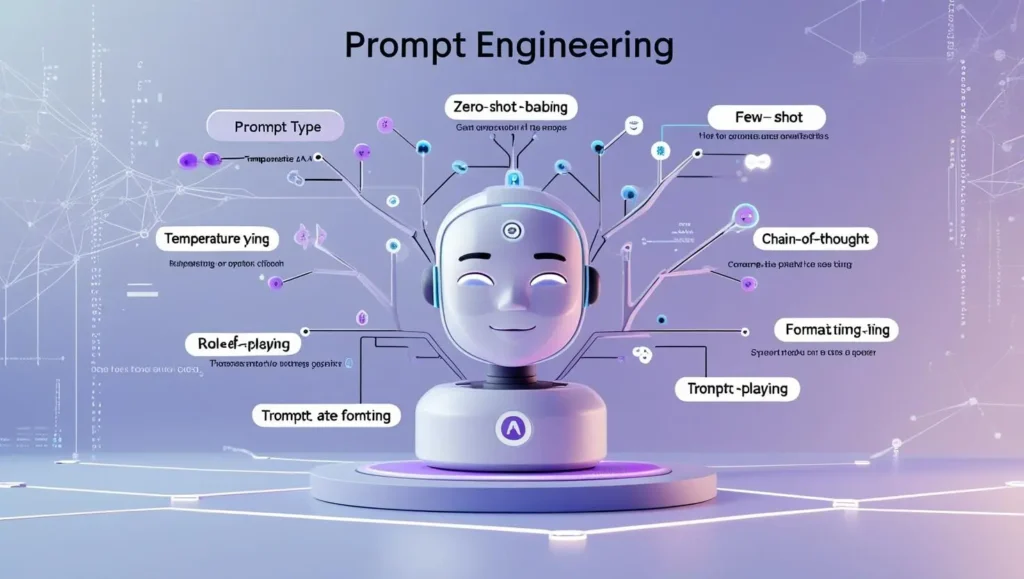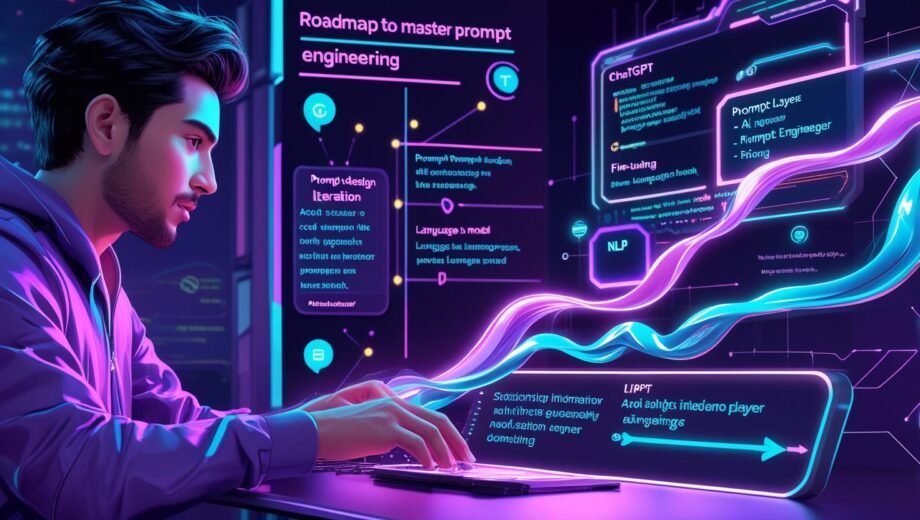In 2025, prompting has emerged as a core digital skill for developers, analysts, and anyone seeking to interact effectively with large language models (LLMs). With tools like ChatGPT, Anthropic’s Claude, and Google Gemini becoming essential to business operations, understanding the art and science of prompt engineering has never been more crucial.
This comprehensive guide is your roadmap to learning prompt engineering for AI, from foundational concepts to career-ready expertise. As AI reshapes industries globally—from healthcare to marketing—professionals with the ability to craft powerful prompts are in demand. Whether you're a developer, student, content strategist, or AI enthusiast, mastering LLM prompts and prompt tuning will unlock your potential in the evolving AI economy.
This roadmap covers:
- What is prompt engineering?
- Step-by-step learning path with six structured phases
- Courses and tools like LearnPrompting
- Real-world applications in various industries
- Innovations by ChatGPT and Anthropic
- Global use cases and future trends
Let’s dive into the evolving world of prompting and how to harness it effectively.
What Is Prompt Engineering?

Prompt engineering is the strategic practice of designing inputs, or “prompts,” that guide LLMs like ChatGPT to produce accurate, creative, and useful outputs. This skill is fundamental to optimizing the performance of generative AI tools.
A prompt could be a simple question, a structured command, or a carefully formatted request. The effectiveness of a model’s response often hinges on how well the prompt is written.
Types of Prompts and Techniques
- Direct Prompts
Example: “Translate this to French: How are you?”
Clear and specific input produces accurate results. - Zero-shot Prompting
Asking the model to perform a task without any examples.
Example: “Summarize this article in three sentences.” - Few-shot Prompting
Providing examples within the prompt to guide the model.
Example: “Translate the following: Hello – Bonjour, Goodbye – Au revoir, Cat –” - Chain-of-Thought Prompting
Encouraging the model to show reasoning steps before the final answer.
Ideal for logical or multi-step tasks.
Prompt engineering helps align AI responses with user intent, reduces hallucinations, and makes AI tools more predictable and productive.
Learning Prompt Engineering Roadmap
To become proficient in prompting, follow this structured six-phase roadmap designed to turn you into a prompt engineering expert.
Phase 1: Fundamentals of AI and LLMs
Start by understanding the ecosystem of artificial intelligence:
- What is an AI model?
- How does natural language processing (NLP) work?
- Key concepts: tokenization, model architecture, transformers, and embeddings.
- Popular models: GPT-4, Claude, Gemini, LLaMA, PaLM.
Recommended Resources
- DeepLearning.AI NLP Specialization
- OpenAI and Anthropic documentation
Phase 2: Basic Prompt Design
Learn how to write effective prompts by practicing:
- Clear, direct instructions
- Proper use of context and formatting
- Iterative testing to compare outputs
- Prompt hygiene: avoiding vague or ambiguous wording
Use tools like the OpenAI Playground or Claude console to experiment and refine your skills.
Phase 3: Advanced Prompt Techniques
Level up your skills with:
- Chain-of-thought prompting for complex problem-solving
- Few-shot examples to train LLMs mid-session
- Instructional prompts vs contextual prompts
- Multimodal prompts combining images and text (emerging trend)
This phase is essential to understand how to adapt prompts for diverse outputs: essays, summaries, chatbot dialogues, or structured data extraction.
Phase 4: Prompt Tuning and Optimization
Here, you refine prompts for specific tasks, including:
- Marketing copy generation
- Legal analysis
- Medical diagnostics
- Educational tutoring
You’ll also learn prompt tuning, a technique where prompts are optimized using machine learning to improve model responses consistently.
Key tools for tuning include:
- LangChain
- PromptLayer
- Guidance by Microsoft
Phase 5: Tooling and Platforms
To streamline your workflow, get comfortable with:
- OpenAI Playground for interactive prompt design
- Anthropic’s Claude interface
- LearnPrompting platform (explained below)
- Prompt engineering plugins on VS Code or via browser extensions
- Prompt optimization APIs (Promptable, Promptist, etc.)
Also, track your experiments and versions using GitHub. See our internal guide:
🔗 GitHub DevOps Roadmap 2025 for CI/CD
Phase 6: Real-World Application & Portfolio Building
Put your skills into action:
- Build a prompt engineering portfolio
- Create open-source prompt repositories on GitHub
- Freelance on platforms like Upwork and Toptal
- Apply for roles like AI Prompt Designer, Conversational UX Writer, or Prompt Engineer
Contribute to communities like Reddit’s r/PromptEngineering or Discord AI communities to network and showcase your work.
Buy Prompt Courses: Learning Opportunities
If you're serious about mastering prompting, investing in courses is a smart move.
Who Should Buy Prompt Courses?
- University students exploring AI careers
- Developers upskilling in generative AI
- Copywriters, marketers, or consultants working with LLM tools
- Researchers and product managers in tech
Course Selection Tips
- Choose hands-on, project-based courses.
- Look for prompting certifications recognized in the AI community.
- Engage in community forums for feedback and collaboration.
Recommended Platforms:
- Udemy’s Master Prompt Engineering for ChatGPT
- LearnPrompting’s Interactive Prompt Challenges
- Coursera’s Prompt Engineering for Everyone
These platforms combine theory with application—critical for long-term retention.
Spotlight on LearnPrompting
LearnPrompting has become a central hub for those learning prompt engineering globally. It offers:
- Interactive tutorials on prompt basics and advanced techniques
- Real-time feedback on prompt quality
- Gamified challenges to test your learning
- Community collaboration for peer learning
Their curriculum is continuously updated based on trends in AI interaction and prompt tuning, making it an excellent evergreen learning platform.
Branded Case Study: ChatGPT & Anthropic
ChatGPT (OpenAI)
ChatGPT offers a user-friendly interface for prompting, making it ideal for both beginners and professionals. Key features:
- Custom GPTs with memory
- Prompt templates
- Shared GPT prompts in public libraries
Example: A custom GPT that acts as a resume writer using few-shot examples and role-playing techniques.
Anthropic's Claude
Anthropic has redefined safety and alignment in prompt engineering with Claude. Notable innovations include:
- Safer prompt design defaults
- Long context windows (up to 200K tokens)
- Strong support for AI ethics
Prompting with Claude emphasizes natural, conversational tone—ideal for legal, HR, and customer service tasks.
Global Prompt Engineering Case Studies
Prompt engineering isn’t confined to Silicon Valley—it’s transforming industries worldwide.
- Healthcare (India)
AI prompts used for summarizing patient histories and assisting telemedicine diagnostics. - Creative Writing (UK)
Journalists and novelists use prompting tools like Jasper or ChatGPT for brainstorming and plot development. - Customer Support (UAE)
Multilingual prompts help AI bots offer real-time support across industries from banking to travel.
These examples highlight how learning prompt engineering for AI offers globally applicable skills.
Challenges and Future Projections
Key Challenges
- Prompt bias: Unintended model behavior due to ambiguous wording
- Ethical concerns: Manipulative or misleading prompt use
- Model limitations: Certain models still struggle with long reasoning chains
The Future of Prompting
- Automated prompt generators using AI
- Multimodal prompting across voice, image, and text
- AI-assisted prompt design tools with error checking and version control
- Prompt compiler frameworks for reusable workflows
The next frontier is prompt engineering + AI agents—where autonomous tools execute chained prompts to complete tasks.
Conclusion
The ability to communicate effectively with AI through prompts is quickly becoming a global digital superpower. Whether you're generating content, coding solutions, or automating business tasks, prompting lies at the heart of the AI revolution.
By following this learning roadmap, using platforms like LearnPrompting, and leveraging tools from OpenAI and Anthropic, you’ll be prepared for the evolving world of prompt-based AI.
Get started today—and shape the future of how we interact with machines.






